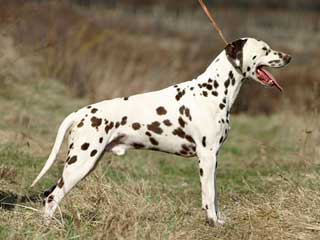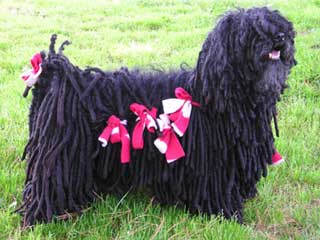| Grooming: |  |  |  |  |  |  |
| Shedding: |  |  |  |  |  |  |
| Energy Level: |  |  |  |  |  |  |
| Protection: |  |  |  |  |  |  |
| Watch Dog: |  |  |  |  |  |  |
| Group: | Non-sporting |
| Size: | Medium |
| Life Span: | 10-12 years |
| Height: | Male: 19-23 inches |
| Female: 19-23 inches | |
| Weight: | Male: 45-60 lbs |
| Female: 45-60 lbs |
Dalmatian Facts
| Coat : | Smooth, dense and glossy |
| Gait : | Balanced and effortless |
| Color(s) : | White with black or liver brown spots. |
| Living Area : | Large |
| Hair Length: | Short |
| Exercise Need : | Daily long walk and jog |
| Recognized By : |
(CKC) Canadian Kennel Club (FCI) F�d�ration Cynologique Internationale (AKC) American Kennel Club (UKC) United Kennel Club (KCGB) Kennel Club of Great Britain (CKC) Canadian Kennel Club (ANKC) Australian National Kennel Council (NKC) National Kennel Club (NZKC) New Zealand Kennel Club (APRI) America Pet Registry, Inc. (ACR) American Canine Registry (DRA) Dog Registry of America |
| Date of Origin : | Ancient |
| Place of Origin : | Croatia |
| Todays Use : | Coach dog, Guardian Dog |
| Originally Used : | Hunting Dog, Guard Dog, Carriage Dog |
| Other Name : | Carriage Dog, Spotted Coach Dog, Firehouse Dog, Plum Pudding Dog |
Dalmatian Information
Dalmatian Description:The origin of the Dalmatian remains disputed to this day despite FCI listing the region of its origin as Dalmatia, Croatia. Some theories suggest that the ancestry of the breed lies in the Pointer, particularly the Bengal Pointer, an ancient breed native to England. However, nothing for certain has been established about the origins of this breed till date. However, what is definitely about this breed is that it was used in a variety of task in the olden days. It was used as hunting dog for hunting vermin and rats; it was also used as a guard dog and even found use as an excellent carriage dog. The breed was first recognized by the AKC in 1888. |
Dalmatian Care & Grooming:The Dalmatian is an average shedder and sheds heavily during spring and fall. Its short and smooth coat is easy to groom. Daily brushing is needed during the shedding season to maintain a healthy looking coat. It should be bathed only when necessary using a mild shampoo. This breed is sensitive to synthetic fibers usually found in upholstery items and thus, should be adequately protected. It is also sensitive to extremely cold temperatures so care should be taken when taking them out. |
Dalmatian Health Problems:The Dalmatian is prone to some health issues like Deafness, Skin allergies, Urinary stones etc. Deafness is a serious health issue for Dalmatians, about 20% Dalmatians are born deaf. Deafness test can be performed when the puppy is about 6 weeks old so caution should be taken while bringing a Dalmatian puppy to home. |
| Group: | Non-sporting |
| Size: | Medium |
| Life Span: | 12-15 years |
| Height: | Male: 16-18 inches Female: 16-18 inches |
| Weight: | Male:45-65 lbs Female: 45-65 lbs |
| Color: | Any solid color like blue, black, gray, si... |
| Description: | The actual origin of the Poodle is bit controversial but as per the AKC, this dog was originated from Germany where it d..... |








-120.jpg)


